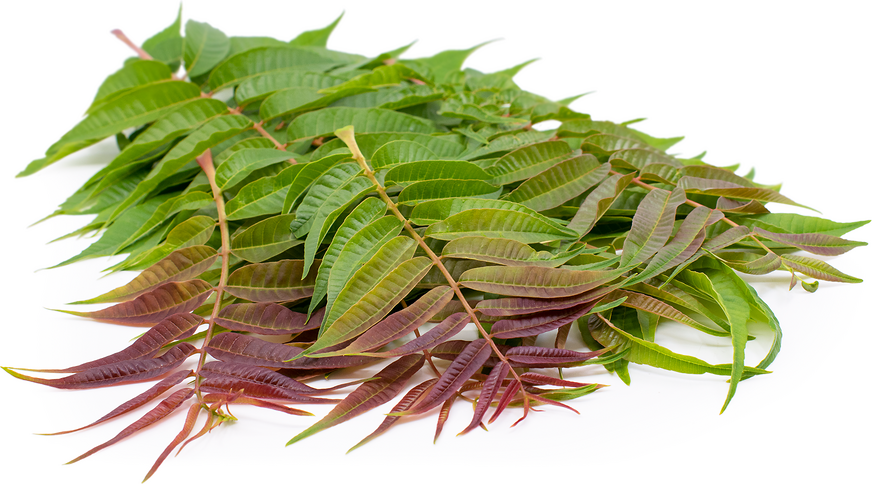


Toon Leaves
Estimated Inventory, bunch : 0
Description/Taste
Toon leaves are small to medium in size and lanceolate or oblong in shape, averaging 20-70 centimeters in length and 30-40 centimeters in width. The branches produce 5-10 pairs of long leaflets that can range in color from dark green to crimson and deep purple. The leaves grow in an alternate pattern, may have smooth or serrated edges, and the shoots and tender young leaves resemble those of a young tomato plant and are enjoyed for their umami flavor. Toon leaves are crisp, crunchy, and distinctly aromatic, offering a floral, onion-like aroma when fresh. When cooked, they impart an earthy, pungent flavor that tastes like a combination of garlic, mustard greens, and fermented chives.
Seasons/Availability
Toon leaves are available year-round with peak season in the spring.
Current Facts
Toon leaves, botanically classified as Toona sinensis, grow on a deciduous perennial tree that can reach up to twenty-five meters in height and are members of the Meliaceae, or mahogany family. Also known as the Chinese cedar, Chinese mahogany, and Red loon, Toon leaves are predominately used in China where they are cultivated as a vegetable. Young Toon leaves are only in season for a few short weeks and are prized for their unique, pungent flavor. The toon tree is also used for its timber in furniture construction and in making guitars.
Nutritional Value
Toon leaves are a good source of antioxidants. They also contain beta-carotene, vitamin E, riboflavin, folic acid, calcium, iron, and protein.
Applications
Toon leaves are best suited for cooked applications such as blanching, stir-frying, roasting, and frying. Toon leaves are most commonly stir-fried with eggs or made into a paste with sesame oil, salt, and sugar, which can be stored in the refrigerator for two months. This paste can be used as a condiment or as a flavoring for noodle and tofu dishes. Toon leaves are also chopped or ground and used to make dumplings, mixed with fresh bean curd as a side dish, blanched and tossed with tofu, oil, and lemon juice for a salad, or dredged in batter and fried as a snack. Toon leaves are only in season for a few weeks in the spring and should be used immediately when fresh. They can also be pickled, dried, salted, or frozen to store for later use.
Ethnic/Cultural Info
Young Toon leaves are highly prized as a vegetable in China. To the Chinese, the appearance of Toon leaf buds means that winter has loosened its grip and spring has officially begun. The Mandarin name for Toon leaves, Xiangchun, also reflects the notion of new beginnings as it translates to "fragrance of spring,” and many toon trees are grown in backyards in China for home cooking. The Toon leaf, bark, fruit, and roots are also all used in traditional Chinese medicine and are believed to help lower blood sugar, help defend the body against oxygen loss, and help reduce fertility issues.
Geography/History
Toon leaves are native to Asia and are believed to have originated specifically in China, where it grows wild on hillside slopes and is also found in home gardens. Toon leaves have been consumed in China since around the time of the Han Dynasty (206 BCE -220 CE) when they found favor with high-ranking officials and wealthy families. Today Toon leaves can be found in specialty markets and grocers in Korea, Nepal, northeastern India, Myanmar, Thailand, Malaysia, Indonesia, and Europe.
Recipe Ideas
Recipes that include Toon Leaves. One
| Madame Huang's Kitchen |
|
Anhui's Toon Leaves Tossed with Fresh Bean Curd |
| ISKCON Desire Tree |
|
Noodles with Chinese Toon |




